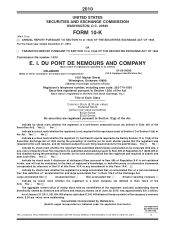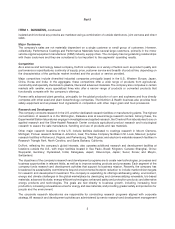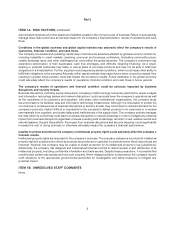DuPont 2010 Annual Report Download - page 9
Download and view the complete annual report
Please find page 9 of the 2010 DuPont annual report below. You can navigate through the pages in the report by either clicking on the pages listed below, or by using the keyword search tool below to find specific information within the annual report.Part I
ITEM 1A. RISK FACTORS, continued
As a result of the company’s current and past operations, including operations related to divested businesses,
the company could incur significant environmental liabilities.
The company is subject to various laws and regulations around the world governing the environment, including the
discharge of pollutants and the management and disposal of hazardous substances. As a result of its operations,
including its past operations and operations of divested businesses, the company could incur substantial costs,
including cleanup costs. The costs of complying with complex environmental laws and regulations, as well as internal
voluntary programs, are significant and will continue to be so for the foreseeable future. The ultimate costs under
environmental laws and the timing of these costs are difficult to predict. The company’s accruals for such costs and
liabilities may not be adequate because the estimates on which the accruals are based depend on a number of factors
including the nature of the matter, the complexity of the site, site geology, the nature and extent of contamination, the
type of remedy, the outcome of discussions with regulatory agencies and other Potentially Responsible Parties (PRPs)
at multi-party sites and the number and financial viability of other PRPs.
The company’s ability to generate sales from genetically modified products, particularly seeds and other
agricultural products, could be adversely affected by market acceptance, government policies, rules or
regulations and competition.
The company is using biotechnology to create and improve products, particularly in its Agriculture & Nutrition segment.
The use of biotechnology to characterize the genetic and performance characteristics of Pioneer seeds provides
Pioneer with competitive advantages in the development of new products, and in the most effective placement of those
products on customer acres. In addition, the company uses biotechnology to enhance the performance of its seed
products through the addition of specific transgenes. The company’s ability to generate sales from such products
could be affected by market acceptance of genetically modified products as well as governmental policies, laws and
regulations that affect the development, manufacture and distribution of products, including the testing and planting of
seeds containing biotechnology traits and the import of commodity grain grown from those seeds.
The company competes with major global companies that have strong intellectual property estates supporting the use
of biotechnology to enhance products, particularly in the agricultural products and production markets. Speed in
discovering and protecting new technologies and bringing products based on them to market is a significant
competitive advantage. Failure to predict and respond effectively to this competition could cause the company’s
existing or candidate products to become less competitive, adversely affecting sales.
Changes in government policies and laws could adversely affect the company’s financial results.
Sales outside the U.S. constitute approximately 65 percent of the company’s 2010 revenue. The company anticipates
that international sales will continue to represent a substantial portion of its total sales and that continued growth and
profitability will require further international expansion, particularly in developing markets. Sales from developing
markets represent approximately 30 percent of the company’s revenue in 2010 and the company’s growth plans
include focusing on expanding its presence in developing markets. The company’s financial results could be affected
by changes in trade, monetary and fiscal policies, laws and regulations, or other activities of U.S. and non-U.S.
governments, agencies and similar organizations. These conditions include, but are not limited to, changes in a
country’s or region’s economic or political conditions, trade regulations affecting production, pricing and marketing of
products, local labor conditions and regulations, reduced protection of intellectual property rights in some countries,
changes in the regulatory or legal environment, restrictions on currency exchange activities, burdensome taxes and
tariffs and other trade barriers. International risks and uncertainties, including changing social and economic
conditions as well as terrorism, political hostilities and war, could lead to reduced sales and profitability.
Economic factors, including inflation, deflation and fluctuations in currency exchange rates, interest rates and
commodity prices could affect the company’s financial results.
The company is exposed to fluctuations in currency exchange rates, interest rates and commodity prices. Because the
company has significant international operations, there are a large number of currency transactions that result from
international sales, purchases, investments and borrowings. The company actively manages currency exposures that
are associated with net monetary asset positions, committed currency purchases and sales, foreign currency-
8






















